Can You Paint Over Rust? Yes, & This is How to Do It
Author: Omar Alonso | Editor: Omar Alonso
Review & Research: Jen Worst & Chris Miller
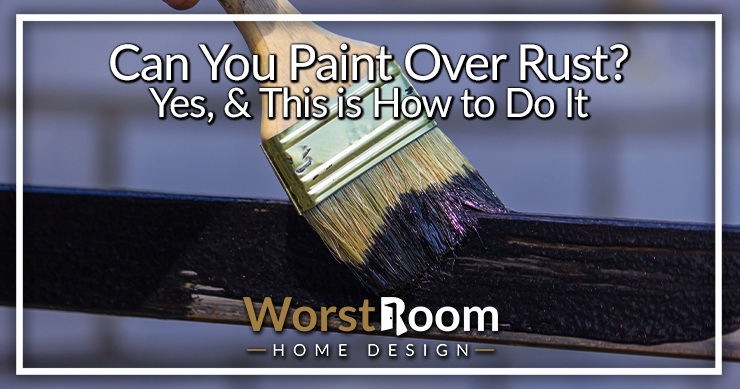
Rusty items can be a real eyesore in your home or garage. The good news is you don't have to throw them away because of their unsightly appearance. Here, we'll offer practical advice on how to paint over rust and not only stop it from spreading but also improve the aesthetic appeal of your item. Ready for a transformation? Keep reading!
Tips for Painting Over Rust
When painting over rust, it's important to distinguish between surface rust and deep rust before you begin. Removing loose rust before painting will help ensure a smooth, long-lasting finish.
Applying a primer formulated for rusted metal is critical for optimal adhesion while choosing the right paint is essential for durability. Avoid using oil-based finishes on galvanized metal surfaces to prevent potential problems.
Surface Rust vs. Extensive Rust
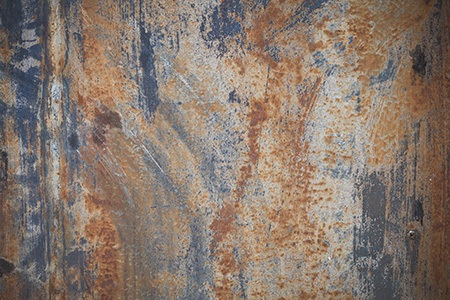
Distinguishing between surface rust and pitting is critical before beginning a painting project. Surface rust affects only the top layer of your metal object, making it easier to manage with proper preparation and quality paint.
Extensive rust, on the other hand, extends deeper into the material's structure and poses greater challenges because it can undermine the integrity of the material over time. For example, extensive rust can negatively affect copper's renowned ductility and thermal properties.
Professional intervention may be required to effectively preserve the item if you're dealing with extensive corrosion. However, milder cases of surface-level deterioration can be painted over using appropriate techniques and products for a revitalized finish.
Removing Loose Rust Before Painting
Removing loose rust from your metal surface is critical in ensuring your paint job lasts. Why is that? Loose rust interferes with the adhesion between the primer and the metal, hindering durability. Do this outside or in a garage or you'll end up needing to get rust out of your carpet.
Start by manually scraping off as much rust as possible with a wire brush or sandpaper, covering all rusty areas thoroughly. Don't cut corners! Heavily corroded surfaces may benefit from power tools such as a rotary sander for more efficient removal.
Once you've finished scraping, be sure to dust off any remaining rust particles-these carefully can also interfere with the bonding process later on. This thorough preparation will pave the way for a quality paint job over the rust. We have an extensive guide on removing rust from tools, too, which will have more tips for you.
Applying a Primer for Paint Adhesion
Priming the rusted surface plays a critical role in ensuring paint adhesion when applying paint over rust. The process involves using a quality rust-inhibiting primer specifically designed for metal surfaces. The reason for this choice is its ability to neutralize existing rust and effectively prevent further corrosion, extending the life of your painted project.
It paves the way for redecorating creativity after the rusty surface has been prepared by providing an excellent base for any color or type of topcoat - be it latex or oil-based. This preparatory primer step ensures that painting over rust will produce professional, long-lasting results by firmly bonding paint to metal and reducing the chance of future flaking.
Choosing the Right Paint for Rusted Metal
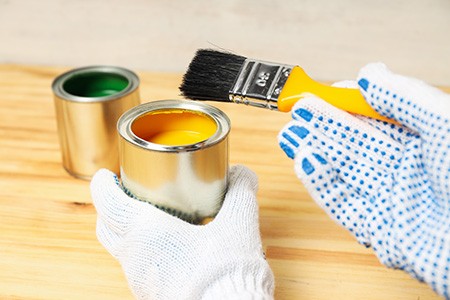
When repainting rusted metal, choosing the right paint is critical to achieving a professional and long-lasting result. A popular choice is Rust-Oleum spray paint, which provides excellent corrosion protection and is available in a variety of colors and finishes.
Another option is to use a rust converter primer to create a stable surface for painting. Real Milk Paint is also favored by many as it adds character to objects with its unique texture and finish.
However, it's important to avoid latex (water-based) paint as it can cause further rusting and staining of the paint. By choosing the right paint, you can ensure better coverage, protection against rust and ultimately improve the durability of your painted surface.
Avoiding Oil-Based Finishes on Galvanized Metal
When painting over rust on galvanized metal, avoiding oil-based finishes is important. Galvanized metal has a special coating that prevents rusting, and oil-based paints can interfere with this protective layer, resulting in poor adhesion and potential damage to the surface.
Instead, choose an acrylic or black paint specifically designed for use on galvanized metal. These paints offer better adhesion and durability while providing a smooth finish.
Avoiding oil-based finishes and choosing the right paint can ensure long-lasting results when painting over rust on galvanized metal. Rust-Oleum Spray Paint is a popular choice that provides excellent coverage and corrosion protection for your galvanized surfaces.
Steps for Painting Over Rust
To paint over rust, first check for structural damage. Next, scrape off excess rust with a wire brush or sandpaper. Apply a quality primer designed for rusted metal and allow it to dry thoroughly before applying the paint of your choice.
Checking for Structural Damage
Before painting over rust, it's important to check for structural damage to ensure a safe and effective paint job. Look for signs of corrosion and deterioration, such as cracks, holes, or weak spots in the metal.
Structural damage can compromise the integrity of the metal surface and may require professional repair before painting. By addressing any structural issues first, you can ensure that your paint job looks great and provides long-lasting protection against further deterioration.
Scraping Off Excess Rust
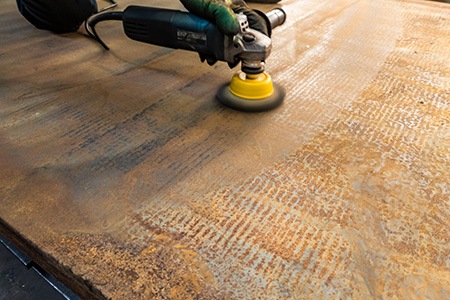
Remove any excess rust before applying paint to achieve a smooth and professional finish when painting over rust. Scraping off the loose rust helps create a clean surface for better adhesion of the new paint.
Use a wire brush or sandpaper to gently scrape away the flaky, corroded areas until you reach the solid metal underneath. This step is essential to prevent further corrosion and ensure that the paint will adhere properly to the surface without peeling or blistering in the future.
Remember to wear protective gloves and goggles during this process to protect yourself from any sharp edges or debris. Once all excess rust has been removed, you're one step closer to a beautifully painted surface that will last for years to come!
Using a Quality Primer
A quality primer is an essential step when painting over rusted metal. Not only does it help create a smooth and even surface for the paint to adhere to, but it also provides added protection against future rust.
When choosing a primer, look for one that is specifically formulated for use on rusty surfaces. These primers are designed to penetrate and seal the rust, preventing it from spreading.
In addition, they often contain corrosion inhibitors to help stop rust in its tracks. Applying a quality primer will ensure your paint job lasts longer and looks professional.
Applying the Paint
Applying the paint is the final step in painting over rust and ensuring long-lasting results. After preparing the surface by removing loose rust and applying a quality primer, it's time to apply the paint.
Using a brush or spray can apply several thin coats of paint over rust evenly to cover the entire rusted area. Be sure to follow the manufacturer's instructions for drying time between coats.
Remember, choosing the right paint is critical for effective protection against further corrosion. Whether you're painting a car or metal tools, investing in high-quality paints designed specifically for rusted surfaces will ensure a professional finish that will stand up to wear and tear.
Recommended Tools & Supplies
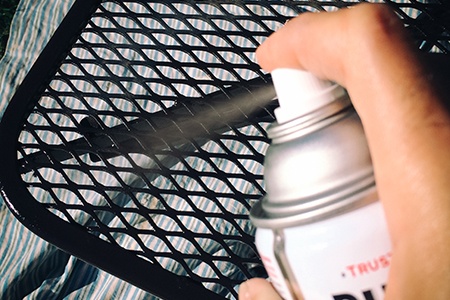
When it comes to painting over rust, having the right tools and supplies is essential to achieving a flawless finish. Rust-Oleum spray paint is highly recommended for its superior coverage and durability.
A high-quality primer explicitly formulated for rust will ensure optimal paint adhesion. And don't forget the topcoat, which adds an extra layer of protection against future rust.
Whether you're using a brush, roller, or sprayer, these tools, combined with the right products, can make your painting project a breeze. Learn more about the best techniques and products in our comprehensive guide to painting over rust!
Rust-Oleum Spray Paint
Rust-Oleum spray paint is a proven solution for painting over rusted metal surfaces. With its premium quality and wide range of options, Rust-Oleum offers the perfect solution for transforming rusty items into vibrant, long-lasting finishes.
Whether you need matte metallic, pearl metallic, or hammered spray paint, Rust-Oleum has you covered. Their universal spray paint can be used on a variety of surfaces, making it versatile for all your DIY projects.
So say goodbye to unsightly rust and hello to a fresh, new look with Rust-Oleum spray paint. Trust the industry leader to get the job done right!
Primer for Rust
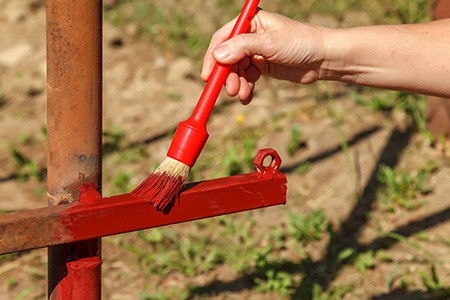
Use a rust primer to ensure a durable, smooth finish when painting over rusted metal. Anti-rust primers are formulated to prevent further rust formation by creating a protective barrier between the surface and the paint.
They contain special ingredients that bind with the existing rust, stopping its progress while providing excellent adhesion for the topcoat. These primers come in a variety of colors, such as light gray or red oxide, which are popular choices for covering rusty surfaces.
Applying a quality primer prior to painting can effectively seal off any remaining rust for a professional-looking finish that will stand the test of time.
Topcoat
Applying a topcoat of paint over rust is essential to ensure the longevity and professional finish of your paint-over-rust project. A topcoat acts as a protective layer that seals in the paint and prevents moisture from reaching the metal surface, which can lead to rusting.
When choosing a topcoat, look for one that is specifically designed for use on metal surfaces. Look for products that offer superior durability and resistance to weathering and UV rays.
In addition, consider choosing a topcoat with anti-rust properties to provide an extra layer of protection against corrosion. Applying a quality topcoat will not only enhance the aesthetic appeal of your painted surface but will also extend its life by providing enhanced rust protection.
Will Painting Over Rust Stop It?
So can you paint over rust? Painting over rust can be a simple yet effective solution to stop the spread of rust and restore the beauty of metal surfaces. You can achieve long-lasting results by following the tips above, such as removing loose rust, applying a primer for adhesion, and choosing the right paint.
Before starting, check for structural damage and use quality tools and supplies such as Rust-Oleum spray paint or specialty primers. With proper preparation and application techniques, you can transform rusty surfaces into beautiful masterpieces that will stand the test of time. So don't let rust hold you back - unleash your creativity with paint over rust!



